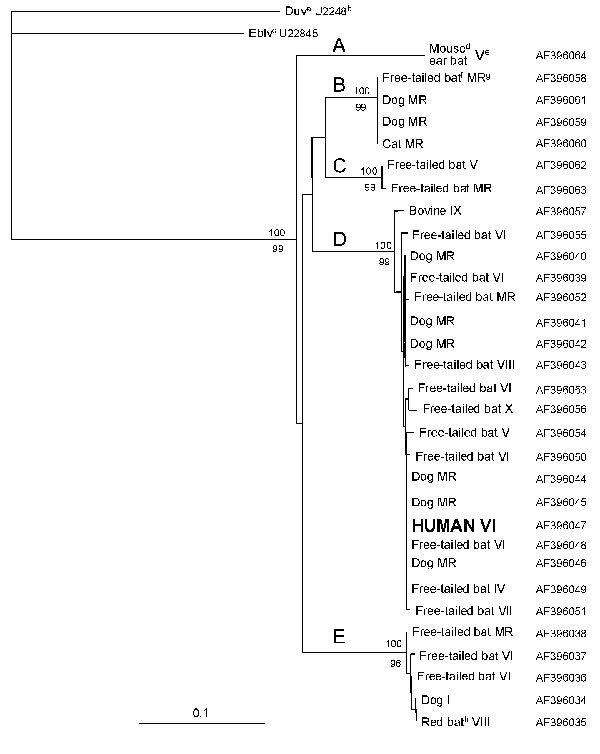Volume 8, Number 1—January 2002
Dispatch
First Case of Human Rabies in Chile Caused by an Insectivorous Bat Virus Variant
Figure 2

Figure 2. Neighbor-joining tree comparing the human rabies isolate with representatives of the rabies genetic variants obtained from insectivorous bats and domestic animals in Chile (18). Bootstrap values obtained from 100 resamplings of the data by using distance matrix (top) and parsimony methods (bottom) are shown at nodes corresponding to the lineages representing the rabies virus variants (A, B, C, D, and E) currently circulating in Chile. Only bootstrap values >50% are shown at the branching points. The bar at the left corner indicates 0.1 nucleotide substitutions per site. aDuvenhage virus, bGenBank accession number, cEuropean bat Lyssavirus, dMyotis chiloensis, eRoman numerals indicate the administrative region where the sample was obtained, fTadarida brasiliensis, gMetropolitan region, hLasiurus borealis.
References
- Carini A. Sur une grande Épizootie de rage. Annales de L’Institut Pasteur (Paris). 1911;25:843–6.
- Pawan JL. The transmission of rabies in Trinidad by the vampire bat. Ann Trop Med Parasitol. 1936;30:101–30.
- Baer GM, Smith JS. Rabies in nonhematophagous bats. In: Baer GM, editor. The natural history of rabies. 2nd ed. Boca Raton (FL): CRC Press; 1991. p. 341-66.
- Acha PN, Arambulo PV III. Rabies in the tropics, history and current status. In: Kuwert E, Merieux C, Koprowski H, Bögel K, editors. Rabies in the Tropics. Berlin: Springer-Verlag; 1985. p. 343-59.
- Favi M, Catalan R. Rabia en murciélagos en Chile. Avances en Ciencias Veterinarias. 1986;1:73–6.
- Favi M, Durán JC. Epidemiología de la rabia en Chile (1929-1988). Avances en Ciencias Veterinarias. 1991;6:13–21.
- de Mattos CA, de Mattos CC, Smith JS, Miller ET, Papo S, Utrera A, Genetic characterization of rabies field isolates from Venezuela. J Clin Microbiol. 1996;34:1553–8.PubMedGoogle Scholar
- Smith JS. Rabies virus epitopic variation use in ecologic studies. Adv Virus Res. 1989;36:215–53. DOIPubMedGoogle Scholar
- Favi M, Yung V, Pavletic C, Ramirez E, de Mattos CC, de Mattos CA. Rol de los murciélagos insectívoros en la transmisión de la rabia en Chile. Archivos de Medicina Veterinaria. 1999;31:157–65.
- Delpietro HA, Gury-Dhomen F, Larghi OP, Mena-Segura C, Abramo L. Monoclonal antibody characterization of rabies virus strains isolated in the River Plate Basin. J Vet Med. 1997;B44:477–83.
- Uieda W, Harmani NMS, Silva MMS. Raiva em morcegos insetívoros (Molossidae) do Sudeste do Brasil. Rev Saude Publica. 1995;29:393–7. DOIPubMedGoogle Scholar
- Loza-Rubio E, de Mattos CC, Aguilar-Setién A, de Mattos CA. Aislamiento y caracterización molecular de un virus rábico obtenido de un murciélago no hematófago en la Ciudad de México. Veterinaria (Mex). 2000;31:147–52.
- Vigilancia epidemiológica de la rabia en las Américas 1996. Boletín de Vigilancia Epidemiológica de las Américas Volume 28. Buenos Aires: Instituto Panamericano de Protección de Alimentos y Zoonosis/Organización Panamericana de la Salud/Organización Mundial de la Salud; 1996.
- Leffingwell L, Irons JV. Rabies antibodies in human serums titrated by the indirect FA method. Public Health Rep. 1965;80:999–1004.PubMedGoogle Scholar
- Dean DJ, Abelseth MK, Atanasiu P. The fluorescent antibody test. In: Meslin F-X, Kaplan MM, Koprowski H, editors. Laboratory techniques in rabies. 4th ed. Geneva: World Health Organization; 1996. p. 88-95.
- Koprowski H. Prueba de inoculación en ratón. In: Kaplan MN, Koprowski H, editors. La rabia, técnicas de laboratorio. 3rd ed. Ginebra (Suiza): Organización Mundial de la Salud; 1976. p. 88-97.
- Diaz AM, Papo S, Rodriguez A, Smith JS. Antigenic analysis of rabies virus isolates from Latin America and the Caribbean. Zentralbl Veterinarmed B. 1994;41:153–60.PubMedGoogle Scholar
- de Mattos CA, Favi M, Yung V, Pavletic C, de Mattos CC. Bat rabies in urban centers in Chile. J Wildl Dis. 2000;36:231–40.PubMedGoogle Scholar
- Smith JS. Rabies virus. In: Murray PR, Baron EJ, Pfaller MA, Tenover FC, Yolken R, editors. Manual of clinical microbiology. Washington: American Society for Microbiology Press; 1995. p. 997-1003.
- Inference Package PHYLIP. [Computer program]. Version 3.5c. Seattle (WA): University of Washington; 1993.
- Page RAM. TREEVIEW: an application to display phylogenetic trees on personal computers. Comput Appl Biosci. 1996;12:357–8.PubMedGoogle Scholar
- Noah DL, Drenzek CL, Smith JS, Krebs JW, Orciari LA, Shaddock J, Epidemiology of human rabies in the United States, 1980 to 1996. Ann Intern Med. 1998;128:922–30.PubMedGoogle Scholar
- Centers for Disease Control and Prevention. Human rabies-- California, Georgia, Minnesota, New York, and Wisconsin, 2000. MMWR Morb Mortal Wkly Rep. 2000;49:1111–5.PubMedGoogle Scholar
- Pape WJ, Fitzsimmons TD, Hoffman RE. Risk for rabies transmission from encounters with bats, Colorado, 1977-1996. Emerg Infect Dis. 1999;5:433–7.PubMedGoogle Scholar